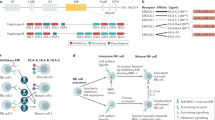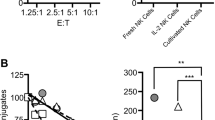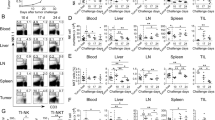Abstract
As natural killer (NK) cells were first described more than 30 years ago—a lifetime in recent immunological history—this is a good time to reflect on their transition from outcasts of mainstream immunology to prominent players in innate immunity. Whereas much of our existing knowledge about NK cells is taken as longstanding fact, it may be surprising to immunologists of a younger vintage, particularly those working on NK cells today, that some of this knowledge was, at least initially, unexpected. In this Perspective, I take an unconventional approach to discussing our progress in understanding NK cells.
This is a preview of subscription content, access via your institution
Access options
Subscribe to this journal
Receive 12 print issues and online access
$209.00 per year
only $17.42 per issue
Buy this article
- Purchase on Springer Link
- Instant access to full article PDF
Prices may be subject to local taxes which are calculated during checkout
Similar content being viewed by others
References
Mitchell, G.J. Report to the Commissioner of Baseball of an Independent Investigation into the Illegal Use of Steroids and Other Performance Enhancing Substances by Players in Major League Baseball (Commissioner of Baseball, 2007).
Brooks, C.G. Reversible induction of natural killer cell activity in cloned murine cytotoxic T lymphocytes. Nature 305, 155–158 (1983).
Lanier, L.L., Phillips, J.H., Hackett, J. Jr., Tutt, M. & Kumar, V. Natural killer cells: definition of a cell type rather than a function. J. Immunol. 137, 2735–2739 (1986).
Anegon, I., Cuturi, M.C., Trinchieri, G. & Perussia, B. Interaction of Fc receptor (CD16) ligands induces transcription of interleukin 2 receptor (CD25) and lymphokine genes and expression of their products in human natural killer cells. J. Exp. Med. 167, 452–472 (1988).
Shellam, G.R., Allan, J.E., Papadimitriou, J.M. & Bancroft, G.J. Increased susceptibility to cytomegalovirus infection in beige mutant mice. Proc. Natl. Acad. Sci. USA 78, 5104–5108 (1981).
Bukowski, J.F., Woda, B.A., Habu, S., Okumura, K. & Welsh, R.M. Natural killer cell depletion enhances virus synthesis and virus-induced hepatitis in vivo. J. Immunol. 131, 1531–1538 (1983).
Degli-Esposti, M.A. & Smyth, M.J. Close encounters of different kinds: dendritic cells and NK cells take centre stage. Nat. Rev. Immunol. 5, 112–124 (2005).
French, A.R. & Yokoyama, W.M. Natural killer cells and viral infections. Curr. Opin. Immunol. 15, 45–51 (2003).
Henkart, P.A. Mechanism of lymphocyte-mediated cytotoxicity. Annu. Rev. Immunol. 3, 31–54 (1985).
Kärre, K., Ljunggren, H.G., Piontek, G. & Kiessling, R. Selective rejection of H-2-deficient lymphoma variants suggests alternative immune defence strategy. Nature 319, 675–678 (1986).
Bix, M. et al. Rejection of class I MHC-deficient haemopoietic cells by irradiated MHC-matched mice. Nature 349, 329–331 (1991).
Lanier, L.L. NK cell recognition. Annu. Rev. Immunol. 23, 225–274 (2005).
Karlhofer, F.M., Ribaudo, R.K. & Yokoyama, W.M. MHC class I alloantigen specificity of Ly-49+ IL-2-activated natural killer cells. Nature 358, 66–70 (1992).
Smith, H.R.C., Karlhofer, F.M. & Yokoyama, W.M. Ly-49 multigene family expressed by IL-2-activated NK cells. J. Immunol. 153, 1068–1079 (1994).
Mason, L.H. et al. Cloning and functional characteristics of murine large granular lymphocyte-1: a member of the Ly-49 gene family (Ly-49G2). J. Exp. Med. 182, 293–303 (1995).
Stoneman, E.R. et al. Cloning and characterization of 5E6 (Ly-49C), a receptor molecule expressed on a subset of murine natural killer cells. J. Exp. Med. 182, 305–313 (1995).
Colonna, M. & Samaridis, J. Cloning of immunoglobulin-superfamily members associated with HLA-C and HLA-B recognition by human natural killer cells. Science 268, 405–408 (1995).
Wagtmann, N. et al. Molecular clones of the p58 NK cell receptor reveal immunoglobulin-related molecules with diversity in both the extra- and intracellular domains. Immunity 2, 439–449 (1995).
Moretta, A. et al. Receptors for HLA class-I molecules in human natural killer cells. Annu. Rev. Immunol. 14, 619–648 (1996).
Lanier, L.L. & Phillips, J.H. Inhibitory MHC class I receptors on NK cells and T cells. Immunol. Today 17, 86–91 (1996).
Westgaard, I.H., Berg, S.F., Orstavik, S., Fossum, S. & Dissen, E. Identification of a human member of the Ly-49 multigene family. Eur. J. Immunol. 28, 1839–1846 (1998).
Vance, R.E., Tanamachi, D.M., Hanke, T. & Raulet, D.H. Cloning of a mouse homolog of CD94 extends the family of C-type lectins on murine natural killer cells. Eur. J. Immunol. 27, 3236–3241 (1997).
Ho, E.L. et al. Murine Nkg2d and Cd94 are clustered within the natural killer complex and are expressed independently in natural killer cells. Proc. Natl. Acad. Sci. USA 95, 6320–6325 (1998).
Rojo, S., Burshtyn, D.N., Long, E.O. & Wagtmann, N. Type I transmembrane receptor with inhibitory function in mouse mast cells and NK cells. J. Immunol. 158, 9–12 (1997).
Wang, L.L., Mehta, I.K., Leblanc, P.A. & Yokoyama, W.M. Cutting edge: mouse natural killer cells express GP49b1, a structural homologue of human killer inhibitory receptors. J. Immunol. 158, 13–17 (1997).
Long, E.O. Regulation of immune responses through inhibitory receptors. Annu. Rev. Immunol. 17, 875–904 (1999).
Trowsdale, J. Genetic and functional relationships between MHC and NK receptor genes. Immunity 15, 363–374 (2001).
Gumperz, J.E. & Parham, P. The enigma of the natural killer cell. Nature 378, 245–248 (1995).
Barten, R., Torkar, M., Haude, A., Trowsdale, J. & Wilson, M.J. Divergent and convergent evolution of NK-cell receptors. Trends Immunol. 22, 52–57 (2001).
Perez-Villar, J.J. et al. Functional ambivalence of the Kp43 (CD94) NK cell-associated surface antigen. J. Immunol. 154, 5779–5788 (1995).
Chang, C. et al. Molecular characterization of human CD94: a type II membrane glycoprotein related to the C-type lectin superfamily. Eur. J. Immunol. 25, 2433–2437 (1995).
Lazetic, S., Chang, C., Houchins, J.P., Lanier, L.L. & Phillips, J.H. Human natural killer cell receptors involved in MHC class I recognition are disulfide-linked heterodimers of CD94 and NKG2 subunits. J. Immunol. 157, 4741–4745 (1996).
Carretero, M. et al. The CD94 and NKG2-A C-type lectins covalently assemble to form a natural killer cell inhibitory receptor for HLA class I molecules. Eur. J. Immunol. 27, 563–567 (1997).
Lanier, L.L., Corliss, B., Wu, J. & Phillips, J.H. Association of DAP12 with activating CD94/NKG2C NK cell receptors. Immunity 8, 693–701 (1998).
Braud, V.M. et al. HLA-E binds to natural killer cell receptors CD94/NKG2A, B and C. Nature 391, 795–799 (1998).
Borrego, F., Ulbrecht, M., Weiss, E.H., Coligan, J.E. & Brooks, A.G. Recognition of human histocompatibility leukocyte antigen (HLA)-E complexed with HLA class I signal sequence-derived peptides by CD94/NKG2 confers protection from natural killer cell-mediated lysis. J. Exp. Med. 187, 813–818 (1998).
Lee, N. et al. HLA-E is a major ligand for the natural killer inhibitory receptor CD94/NKG2A. Proc. Natl. Acad. Sci. USA 95, 5199–5204 (1998).
Yokoyama, W.M. HLA class I specificity for natural killer cell receptor CD94/NKG2A: two for one in more ways than one. Proc. Natl. Acad. Sci. USA 95, 4791–4794 (1998).
Yokoyama, W.M., Jacobs, L.B., Kanagawa, O., Shevach, E.M. & Cohen, D.I. A murine T lymphocyte antigen belongs to a supergene family of type II integral membrane proteins. J. Immunol. 143, 1379–1386 (1989).
Daniels, B.F., Nakamura, M.C., Rosen, S.D., Yokoyama, W.M. & Seaman, W.E. Ly-49A, a receptor for H-2Dd, has a functional carbohydrate recognition domain. Immunity 1, 785–792 (1994).
Matsumoto, N., Ribaudo, R.K., Abastado, J.-P., Margulies, D.H. & Yokoyama, W.M. The lectin-like NK cell receptor Ly-49A recognizes a carbohydrate-independent epitope on its MHC class I ligand. Immunity 8, 245–254 (1998).
Tormo, J., Natarajan, K., Margulies, D.H. & Mariuzza, R.A. Crystal structure of a lectin-like natural killer cell receptor bound to its MHC class I ligand. Nature 402, 623–631 (1999).
Matsumoto, N., Mitsuki, M., Tajima, K., Yokoyama, W.M. & Yamamoto, K. The functional binding site for the C-type lectin-like natural killer cell receptor Ly49A spans three domains of its major histocompatibility complex class I ligand. J. Exp. Med. 193, 147–158 (2001).
Wang, J. et al. Binding of the natural killer cell inhibitory receptor Ly49A to its major histocompatibility complex class I ligand. Crucial contacts include both H-2Dd and β2-microglobulin. J. Biol. Chem. 277, 1433–1442 (2002).
Weis, W.I. & Drickamer, K. Structural basis of lectin-carbohydrate recognition. Annu. Rev. Biochem. 65, 441–473 (1996).
Doyle, A.C. A scandal in Bohemia. In The Adventures of Sherlock Holmes (George Newnes, London, 1892).
O'Leary, J.G., Goodarzi, M., Drayton, D.L. & von Andrian, U.H. T cell– and B cell–independent adaptive immunity mediated by natural killer cells. Nat. Immunol. 7, 507–516 (2006).
Doucey, M.-A. et al. Cis association of Ly49A with MHC class I restricts natural killer cell inhibition. Nat. Immunol. 5, 328–336 (2004).
Kim, S. et al. Licensing of natural killer cells by host major histocompatibility complex class I molecules. Nature 436, 709–713 (2005).
Vosshenrich, C.A. et al. A thymic pathway of mouse natural killer cell development characterized by expression of GATA-3 and CD127. Nat. Immunol. 7, 1217–1224 (2006).
Cooper, M.A., Fehniger, T.A. & Caligiuri, M.A. The biology of human natural killer-cell subsets. Trends Immunol. 22, 633–640 (2001).
Yu, Y.Y.L., Kumar, V. & Bennett, M. Murine natural killer cells and marrow graft rejection. Annu. Rev. Immunol. 10, 189–213 (1992).
Anfossi, N. et al. Human NK cell education by inhibitory receptors for MHC class I. Immunity 25, 331–342 (2006).
Raulet, D.H. & Vance, R.E. Self-tolerance of natural killer cells. Nat. Rev. Immunol. 6, 520–531 (2006).
Yokoyama, W.M. & Kim, S. How do natural killer cells find self to achieve tolerance? Immunity 24, 249–257 (2006).
Acknowledgements
I thank past and present members of my laboratory and the many investigators in the NK cell field whose contributions have enriched and enlightened the field. Unfortunately, many could not be mentioned because of space constraints. Thanks also to M. Cooper, A. French, H. Jonsson and J. Sunwoo for critical review of this manuscript and to L. Carayannopoulos, J. Heusel, K. Iizuka, S. Kim, B. Plougastel and E. Unanue for suggestions. Supported by the Howard Hughes Medical Institute and the US National Institutes of Health.
Author information
Authors and Affiliations
Corresponding author
Ethics declarations
Competing interests
The author declares no competing financial interests.
Rights and permissions
About this article
Cite this article
Yokoyama, W. Mistaken notions about natural killer cells. Nat Immunol 9, 481–485 (2008). https://doi.org/10.1038/ni1583
Published:
Issue Date:
DOI: https://doi.org/10.1038/ni1583
This article is cited by
-
Critical functions for STAT5 tetramers in the maturation and survival of natural killer cells
Nature Communications (2017)
-
Chimeric antigen receptor (CAR)-modified natural killer cell-based immunotherapy and immunological synapse formation in cancer and HIV
Protein & Cell (2017)
-
Increased expressions of NKp44, NKp46 on NK/NKT-like cells are associated with impaired cytolytic function in self-limiting hepatitis E infection
Medical Microbiology and Immunology (2014)
-
A “memorable” NK cell discovery
Cell Research (2009)
-
Hidden talents of natural killers: NK cells in innate and adaptive immunity
EMBO reports (2009)



